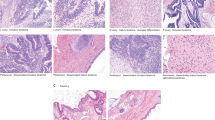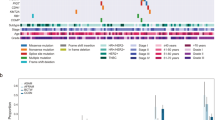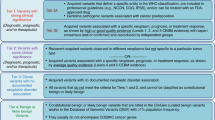Abstract
Detailed deletion mapping of chromosome 6q sequences in invasive ovarian tumors have implicated several broad regions involving 6q14 – 16, 6q21 – 23, 6q25 – 26, and the telomeric portion in band 6q27 as regions of frequent loss in this malignancy. In order to define regions of loss involved in the development of ovarian cancer, we used 23 polymorphic markers on 6q to examine allelic loss in 25 high-grade, late stage ovarian tumors. Four non-overlapping deletion regions were observed: (1) at 6q21 – 22.3 (D6S301-D6S292); (2) within a 1 cM region at 23.2 – 23.3 between markers D6S978-D6S1637 (at D6S311); (3) at 6q26 (between markers D6S411-D6S1277) and (4) at 6q27 with the markers D6S297 and D6S193. The highest region of loss was observed with marker D6S311 (lost in 17 of 19 informative cases, 89%) in 6q23.3, followed by D6S977 and D6S1637 (71 and 55%, respectively). The average fractional allele loss in the high-grade tumors was around 35%. Previous reports have shown 6q27 as the region of most frequent loss in invasive ovarian cancer. However, our results indicate a novel region in 6q23.3 (spanning less than 500 Kb distance between the markers) with the highest loss, implicating this region of chromosome 6q to harbor a putative tumor suppressor gene involved in the development of invasive epithelial ovarian cancer.
This is a preview of subscription content, access via your institution
Access options
Subscribe to this journal
Receive 50 print issues and online access
$259.00 per year
only $5.18 per issue
Buy this article
- Purchase on Springer Link
- Instant access to full article PDF
Prices may be subject to local taxes which are calculated during checkout


Similar content being viewed by others
References
Abdollahi A, Roberts D, Godwin AK, Schultz DC, Sonoda G, Testa JR and Hamilton TC. . 1997 Oncogene 14: 1973–1979.
Banga SS, Kim S, Hubbard K, Dasgupta T, Jha KK, Kraemer P and Ozer HL. . 1997 Oncogene 14: 313–321.
Bell DW, Jhanwar SC and Testa JR. . 1997 Cancer Res. 57: 4057–4062.
Cannistra SA. . 1993 N. Engl. J. Med. 329: 1550–1559.
Chappell SA, Walsh T, Walker RA and Shaw JA. . 1997 Br. J. Cancer 75: 1324–1329.
Church SL, Grant JW, Ridnour LA, Oberley LW, Swanson PE, Meltzer PS, Trent JM . 1993 Proc. Natl. Acad. Sci. USA 90: 3113–3117.
Cliby W, Ritland S, Hartmann L, Dodson M, Halling KC, Keeney G, Podratz KC and Jenkins RB. . 1993 Cancer Res. 53: 2393–2398.
Colitti CV, Rodabaugh KJ, Welch WR, Berkowitz RS and Mok SC. . 1998 Oncogene 16: 555–559.
Collins A, Frezal J, Teague J and Morton NE. . 1996 Proc. Natl. Acad. Sci. USA 93: 14771–14775.
Cooke IE, Shelling AN, Meuth VG, Charnock ML and Ganesan TS. . 1996 Genes Chromosom. Cancer 15: 223–233.
Cooney KA, Wetzel JC, Consolino CM and Wanjo KJ. . 1996 Cancer Res. 56: 4150–4156.
Dodson MK, Hartmann LC, Cliby WA, DeLacey KA, Keeney GL, Ritland SR, Su JQ, Podratz KC and Jenkins RB. . 1993 Cancer Res. 53: 4456–4460.
Foulkes WD, Ragoussis J, Stamp GW, Allan GJ and Trowsdale J. . 1993 Br. J. Cancer 67: 551–559.
Guan XY, Horsman D, Zhang HE, Parsa NZ, Meltzer PS and Trent JM. . 1996 Blood 88: 1418–1422.
Hauptschein RS, Gamberi B, Rao PH, Frigeri F, Scotto L, Venkatraj VS, Gaidano G, Rutner T, Edwards YH, Chaganti RS and Dalla-Favera R. . 1998 Genomics 50: 170–186.
Henderson BE, Ross RK and Pike MC. . 1991 Science 254: 1131–1138.
Jiang X, Hitchcock A, Bryan EJ, Watson RH, Englefield P, Thomas EJ and Campbell IG. . 1996 Cancer Res. 56: 3534–3539.
Landis SH, Murray T, Bolden S and Wingo PA. . 1998 Cancer J. Clin. 48: 6–29.
Leary JA, Doris CP, Boltz EM, Houghton CRS, Kefford RF and Friedlander ML. . 1993 Int. J. Gynecol. Cancer 3: 293–298.
Lee JH, Kavanagh JJ, Wildrick DM, Wharton JT, Blick M. . 1990 Cancer Res. 50: 2724–2728.
Morelli C, Sherratt T, Trabanelli C, Rimessi P, Gualandi F, Greaves MJ, Negrini M, Boyle JM and Barbanti-Brodano G. . 1997 Cancer Res. 57: 4152–4157.
Orphanos V, McGown G, Hey Y, Thorncroft M, Santibanez-Koref M, Russell SE, Hickey I, Atkinson RJ and Boyle JM. . 1995 Br. J. Cancer 71: 666–669.
Quimado L, Seruca R, Costa-Periera A and Castedo S. . 1995 Genes Chromosom. Cancer 14: 28–34.
Rodabaugh KJ, Blanchard G, Welch WR, Bell DA, Berkowitz RS, Mok SC. . 1995 Cancer Res. 55: 2169–2172.
Saito S, Saito H, Koi S, Sague S, Kudo R, Saito J, Noda K and Nakamura Y. . 1992 Cancer Res. 52: 5815–5817.
Saito S, Sirahama S, Matsushima M, Suzuki M, Sagae S, Kudo R, Saito J, Noda K and Nakamura Y. . 1996 Cancer Res. 56: 5586–5589.
Sandhu AK, Hubbard K, Kau GP, Jha KK, Ozer HL and Athwal RS. . 1994 Proc. Natl. Acad. Sci. USA 91: 5498–5502.
Sheng SM, Marchetti A, Buttitta F, Champeme MH, Campani D, Bistocchi M, Lidereau R and Callahan R. . 1996 Br. J. Cancer 73: 144–147.
Shridhar R, Shridhar V, Wang X, Paradee W, Dugan M, Sarkar F, Wilke C, Glover TW, Vaitkevicius V and Smith DI. . 1996 Cancer Res. 56: 4347–4350.
Shridhar V, Siegfried J, Hunt J, Maria del Mar A and Smith DI. . 1994 Cancer Res. 54: 2084–2087.
Shridhar V, Wang L, Rosati R, Paradee W, Shridhar R, Mullins C, Sakr W, Grignon G, Miller OJ, Qi C Sun Petros J and Smith DI. . 1997 Oncogene 20: 1269–1277.
Theile M, Seitz S, Arnold W, Jandrig B, Frege R, Schlag PM, Haensch W, Guski H, Winzer KJ, Barrett JC and Scherneck S. . 1996 Oncogene 13: 677–685.
Tibiletti MG, Trubia M, Ponti E, Sessa L, Acquati F, Furlan D, Bernasconi B, Fichera M, Mihalich A, Ziegler A, Volz A, Facco C, Riva C, Cremonesi L, Ferrari M and Taramelli R. . 1998 Oncogene 16: 1639–1642.
Walker GJ, Palmer JM, Walters MK, Nancarrow DJ, Parsons PJ and Hayward NK. . 1994 Int. J. Cancer 58: 203–206.
Wang ND, Testa JR and Smith DI. . 1993 Genomics 17: 341–347.
Acknowledgements
The authors would like to give thanks to Dr G Keeny for the assessment of the tumor content in the cryostat sections. This work was supported by NIH grant CA 48031 to Dr DI Smith.
Author information
Authors and Affiliations
Additional information
Department of Medical Oncology, Mayo Clinic/Foundation, Rochester, Minnesota, MN 55905, USA
Rights and permissions
About this article
Cite this article
Shridhar, V., Staub, J., Huntley, B. et al. A novel region of deletion on chromosome 6q23.3 spanning less than 500 Kb in high grade invasive epithelial ovarian cancer. Oncogene 18, 3913–3918 (1999). https://doi.org/10.1038/sj.onc.1202756
Received:
Revised:
Accepted:
Published:
Issue Date:
DOI: https://doi.org/10.1038/sj.onc.1202756
Keywords
This article is cited by
-
Post-translational modification of Parkin and its research progress in cancer
Cancer Communications (2019)
-
Parkin in Parkinson’s Disease and Cancer: a Double-Edged Sword
Molecular Neurobiology (2018)
-
Very large common fragile site genes and their potential role in cancer development
Cellular and Molecular Life Sciences (2014)
-
Frequent down-regulation of HIVEP2 in human breast cancer
Breast Cancer Research and Treatment (2005)
-
SASH1: a candidate tumor suppressor gene on chromosome 6q24.3 is downregulated in breast cancer
Oncogene (2003)



